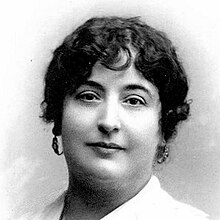Carmen de Burgos


Carmen de Burgos y Seguí (pseudonyms, Colombine, Gabriel Luna, Perico el de los Palotes, Raquel, Honorine and Marianela; Almería, December 10, 1867 – Madrid, October 9, 1932) was a Spanish journalist, writer, translator and women's rights activist. Johnson describes her as a "modern" if not "modernist" writer.[1]
Early years
She was born in 1867 in Almeria to a middle-class family, in which her father owned a gold mine. Her father José de Burgos Cañizares and her uncle Ferdinand were in charge of the vice-consulate of Portugal in Almeria. Her mother, Nicosia Segui Nieto, had come to the marriage with a substantial inheritance.[2]
Career
She escaped her family when she met Arturo Asterz Bustos. He was fifteen years older than her; he was a poet, writer, and an alcoholic. Her new husband earned money as a typesetter on the family's newspaper, but she quickly discovered that this was to be her work. She and Arturo were unhappily married for 17 years, having four children - of whom only one survived. Burgos regarded herself as a feminist but her gender meant that her writings were not included when evaluations were made of Spanish (male) modernism.
However Burgos was nominally creating a number of novels for the "weekly novel" market that was popular at the start of the twentieth century. Burgos's novels however dealt with legal and political themes. Her novels dealt with taboo subjects including male and female homosexuality. She highlighted the dual values applied that blamed women who were adulterers whereas men's involvement was forgiven. Women were given responsibility for illegitimate children and the law overlooked the abuse that some women found within their marriages.[5] It has been noted that Burgos raised controversial subjects concerning gender, the law and rights but her writing did not offer a solution.[3] She exposed to the readers the disparity between traditional values of female education and modern life.[5] Burgos however exposed difficult issues as a dramatic event and in 1904 she had led a campaign to improve the availability of divorce.[3]
Recognition
In 1906, Burgos became the first female professional journalist in Spain as editor of Madrid's Diario Universal.
Selected works
ISBNs for the books listed. . (October 2023) |
Essays and other works
- Ensayos literarios, 1900.
- Álbum artístico literario del siglo XX, 1901.
- Notas del alma, 1901, (colección de coplas populares)
- El divorcio en España, 1904.
- La mujer en España, 1906.
- Por Europa, 1906
- La voz de los muertos, 1911
- Leopardi, 1911
- Misión social de la mujer, 1911
- Cartas sin destinatario, 1912
- Al balcón, 1913
- Impresiones de Argentina, 1914
- Confidencias de artistas, 1916
- Peregrinaciones, 1917
- Mis viajes por Europa, 1917
- ¿Quiere usted comer bien?, 1917
- Fígaro, 1919
- La Emperatriz Eugenia, 1920
- Hablando con los descendientes, 1929
- Gloriosa vida y desdichada muerte de D. Rafael del Riego, 1931.
- Amadís de Gaula, s.a.
Novels
Short stories
- Ensayos literarios, 1900.
- Alucinación, 1905
- El anhelo
- El abogado
- El artículo 438
- Cuentos: El tesoro del castillo
- Cuentos de Colombine
- En la guerra
- Honor de familia
Translations
- Historia de mi vida (muda, sorda y ciega), 1904
- La guerra ruso-japonesa, 1904.
- La inferioridad mental de la mujer, 1904.
- Loca por razón de Estado, 1904.
- Los Evangelios y la segunda generación cristiana, 1904
- La Iglesia cristiana, 1905
- Diez y seis años en Siberia, 1906.
- En el mundo de las mujeres, 1906.
- El rey sin corona, 1908.
- La conquista de un Imperio, 1911.
- Los misterios de la india, 1911.
- La corona de olivo silvestre, 1911-1913.
- Fisiología del placer, 1913.
- Las mañanas en Florencia, 1913
- Las piedras de Venecia, 1913.
- Las siete lámparas de la arquitectura, 1913.
- Los pintores modernos. El paisaje, 1913.
- Cuentos a Maxa, 1914.
- El reposo de San Marcos. Historia de Venecia, 1915.
- La Biblia de Amiens, 1916.
- La decisión, 1917.
- Una idea de parisiense por página, 1917.
- La perseverancia, 1919.
- Defnis y Cloe, 1910.
- Los últimos filibusteros, 1913.
- La princesa muda, s.a.
- El tío Geromo (Crainqueville).
- Cuentistas italianos.
Translations into English
- Take Six: Six Spanish Women Writers, edited and translated by Kathryn Phillips-Miles and Simon Deefholts, Dedalus Books, 2022: Contains a selection of her stories in English translation.
- — (2023). "The Russian Princess". In Reigh, Gabi (ed.). Virginia's Sisters. Translated by Slava Faybysh. OCLC 1377211507.
References
- JSTOR 3190302.
- ^ a b c Carmen der Burgos "La Columbine" Archived April 2, 2015, at the Wayback Machine, turismodealmeria.org. Retrieved March 29, 2015.
- ^ ISBN 1855661217.
- ISBN 0567559580.
- ^ ISBN 0521778158.
- ^ ISBN 978-0-19-514890-9.
- ^ Texto de La mujer fantástica en la BNE
- ^ Texto de Los anticuarios en BNE
Bibliography
- Núñez Rey, Concepción (2014). "Un puente entre España y Portugal: Carmen de Burgos y su amistad con Ana de Castro Osório". ARBOR Ciencia, Pensamiento y Cultura (in Spanish). 190 (766). ISSN 0210-1963. Archived from the original(pdf) on June 7, 2014. Retrieved September 5, 2016.
- Memorias de Colombine, la primera periodista (ISBN 84-923433-1-1) por Utrera, Federico. – Majadahonda: Hijos de Muley-Rubio, 1998. (in Spanish)
- Carmen de Burgos Colombine (ISBN 84-670-1266-8) por Bravo Cela, Blanca. (in Spanish)
- Carmen de Burgos, Colombine (1867–1932). Biografía y obra literaria. Tesis doctoral a cargo de Concepción Núñez Rey. Universidad Complutense de Madrid, 1992. (in Spanish)
- Ramírez Gómez, Carmen (2000). Mujeres escritoras en la prensa andaluza del siglo XX (1900–1950). Literatura. Vol. 41. Sevilla: Universidad de Sevilla. ISBN 9788447205608. (in Spanish)
- Valdés, Asunción (2021). Revivir (in Spanish). ISBN 978-84-7784-828-8.
External links
- Works by Carmen de Burgos at LibriVox (public domain audiobooks)

